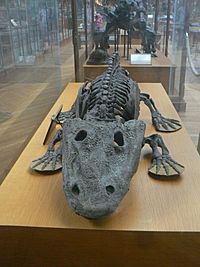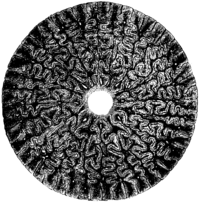Labyrinthodont facts for kids
Labyrinthodont is a term which was used for fossil amphibia. Although it is no longer a formal term in taxonomy, it is still useful as an evolutionary grade, a kind of catch-all term. Labyrinth mean a maze and dont means tooth.
Labyrinthodonts are often called Temnospondyls. The Labyrinthodontia is not a clade, because it is not monophyletic. It has been replaced in the classification by more correct terms.
The labyrithodonts were some of the dominant animals from the Devonian to the Lower Triassic (about 390 to 210 million years ago). The group is an evolutionary grade (a polyphyletic or paraphyletic group) of species which look rather similar.
The name describes the pattern of infolding of the dentine and enamel of the teeth, which often fossilise. They are also have a heavily armoured skull roof (so they also have an even older name "Stegocephalia"), and complex vertebrae.
Contents
Characteristics
The labyrinthodonts flourished for more than 200 million years. Although there was much variation, these traits make their fossils distinct and easy to recognise:
- Strongly folded tooth surface, so that a cross section resembles a classical labyrinth (or maze).
- Massive skull roof, with openings only for the nostrils, eyes and a parietal 'third eye'. The skull was rather flat with thick dermal armour, accounting for the older term for the group: Stegocephalia. The amniotes (Sauropsids and Synapsids) developed deeper skulls.
- Otic notch behind each eye at the back edge of the skull. In the primitive waterbound forms it may have formed an open spiracle, and may possibly have held an ear-drum in some advanced forms.
- Complex vertebrae made of 4 pieces.
What the term included
- †Ichthyostegalia : term no longer used; see 'Fishapods', below.
- †Temnospondyli (possible ancestors of modern amphibians)
- †Lepospondyli (possible ancestors of modern amphibians)
- †Reptiliomorpha (ancestors of reptiles): now referred to the Amniote stem-group or the Sauropsida.
Specifically excluded
- Lissamphibians: modern amphibia
- Amniotes: The terrestrial cleidoic egg-laying animals, the Sauropsida and Synapsida.
Fishapods

• Panderichthys, suited to muddy shallows;
• Tiktaalik with limb-like fins that could take it onto land;
• Early tetrapods in weed-filled swamps, such as:
• Acanthostega which had feet with eight digits,
• Ichthyostega with limbs.
Descendants also included pelagic lobe-finned fish such as coelacanth species.
Early tetropods are now classified as lobe-finned fish (Sarcopterygii). This is because we now know they were aquatic when the limbs first evolved (see Tetrapod).
The informal term fishapods is often used for this group of Devonian animals.
A more formal term, used by Clack, is "stem-group tetrapods".
Images for kids
-
Skeletal reconstruction of Acanthostega, an early (ichthyostegalian) labyrinthodont
-
Reconstruction of Branchiosaurus, a temnospondyl tadpole or paedomorph form with external gills
-
Acanthostega, a fish-like early ichthyostegalian
-
Seymouria, a terrestrial reptiliomorph from the Permian
-
Platyoposaurus, an advanced crocodile-like temnospondyl from the Permian
-
Eryops, a well known euskelian temnospondyl
-
Hyloplesion, a salamander-like lepospondyl
-
Tiktaalik, a transitional form between tetrapodomorph fish and labyrinthodonts, combining fishlike fins with a pectoral girdle separate from the skull
-
Pederpes, a six-fingered labyrinthodont from the fossil-poor Romer's gap
-
The waterways of coal forests, the typical primal hunting grounds of Carboniferous labyrinthodonts
-
The amphibamid temnospondyl Gerobatrachus from the Permian, proposed ancestor of lissamphibians
-
Classical 19th century interpretation of stegocephalians from the Crystal Palace, based on anuran amphibians
See also
 In Spanish: Labyrinthodontia para niños
In Spanish: Labyrinthodontia para niños
















